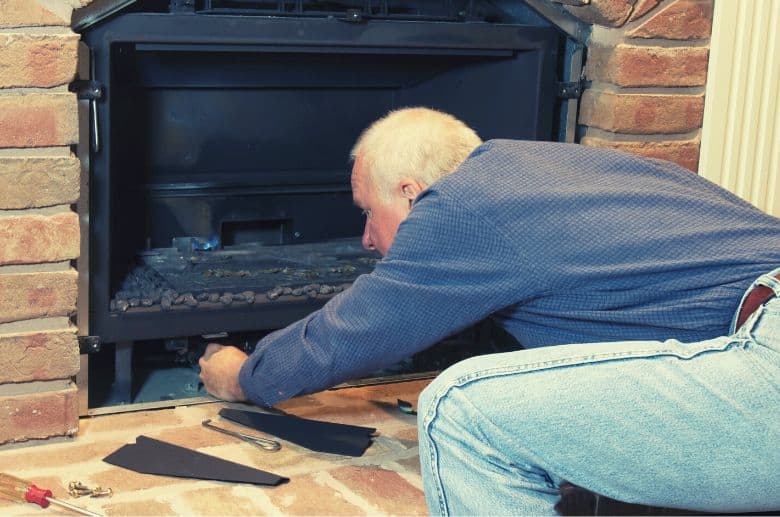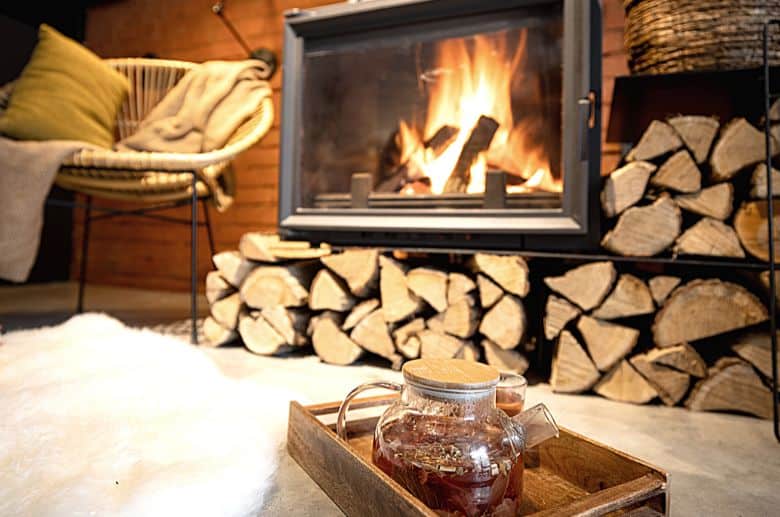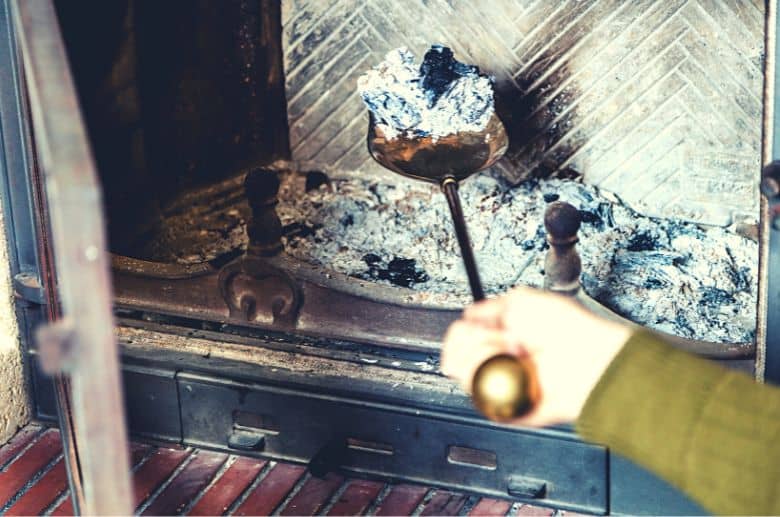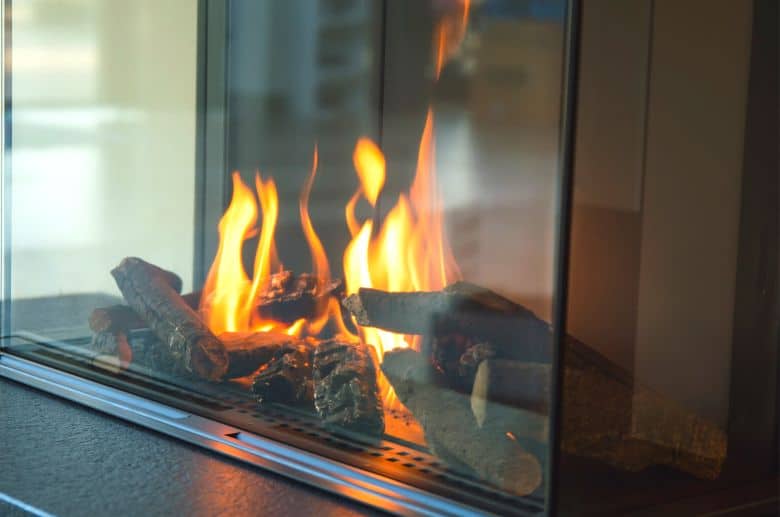Whether you’re looking to get a fireplace for your new home or thinking of replacing your old, worn-out fireplace, it’s important to compare gas and wood-burning fireplaces.
A thorough understanding of these technologies will help you decide which suits your requirements.
The following article gives a thorough comparison of gas vs wood burning fireplaces based on various parameters, including convenience, operational costs, maintenance, pollution, durability, and more.
Gas vs Wood Burning Fireplace Features Face to Face
Let’s compare the gas vs wood-burning fireplace based on the most important fireplace features.
| Wood-Burning Fireplaces | Gas Fireplaces | |
| Ease of Use | Need to stack firewood and use kindling to start a fire | Easy to operate, remotely accessible |
| Fuel Storage | Need to store firewood, keep it dry and ventilated | No fuel storage is required, as natural gas comes in through pipes |
| Fireplace Safety and Health | Burning embers can burn furniture and hurt kids or pets | Safe to use |
| Fireplace Efficiency | About 30% efficiency | Up to 99% efficiency |
| Fireplace Maintenance | Regular maintenance and cleaning of creosote required | Little to no maintenance |
| Operational Cost | Relatively costly | Relatively cheap |
| Ecofriendliness | Toxic gasses are produced | Produces 99% fewer pollutants |
| Aesthetic Appeal | Gives a natural and traditional feel | Looks good but cannot match the feel of a traditional fireplace |
| House Resale Value | Increases home value | Increases home value |
| Life Expectancy | Masonry fireplaces can last a lifetime | 15 to 20 years lifespan |
Fireplace Ease of Use

Gas fireplaces win this one by a clear margin. Press the button next to the fireplace, and the warmth roars into your room. Some gas fireplaces come with a remote, which further eases the process.
Compared to that, wood-burning fireplaces with their various types need a lot of effort to ignite. You have to stack wood and kindling in the fireplace correctly. Then you need to light the firewood and tend to it until it can sustain itself.
Some people consider the process of building a wood fire amusing and ceremonial. Still, many homeowners don’t want to go through such a long process, especially when they just want to relax in a warm, cozy environment.
Fuel Storage

Gas fireplaces don’t require fuel storage because gas comes in through a pipe. But some areas of the country don’t have reliable natural gas services. Homeowners living in such areas use propane as an alternative. Since propane comes in large tanks, it can be quite a headache to get it to the site.
Firewood for wood fireplaces needs to be stored in racks. You must be careful when storing firewood since it needs to be ventilated. Ventilation is important to allow the moisture to evaporate from the firewood to make it burn better. You also need to protect it from rainwater and mold growth.
If you have natural gas in your area, gas fireplaces are much better for fuel storage.
Fireplace’s Safety
Gas fireplaces are much safer than wood-burning fireplaces because they don’t produce embers. Embers can fly out of the wood-burning fireplace, damage furniture, or even hurt someone. They can even hide in grey and dead ashes, but the embers are still alive there.
While gas fireplaces are safer by default, homeowners can make their wood-burning fireplaces safer by installing a fireplace glass door and a child-proof screen. This is important, especially if you have small children or pets roaming around anywhere near the flame.
It’s also important to look at the overall safety of the fireplace and chimney system. Dangerous emissions and fumes, such as carbon monoxide, can come back into your home if a fireplace has improper installation, doesn’t get regular service or maintenance, or has serious issues that require immediate repair. Whether you use a gas line or build fires with wood, every homeowner should inspect their heating source regularly.
Efficiency
Wood-burning fireplaces produce a lot of heat. The fire inside the fireplace can reach temperatures up to 1,100 degrees Fahrenheit. But most of the heat produced inside the fireplace escapes through the chimney.
Moreover, the hot air inside the chimney rises, creating an upward draft that can pull warm air from inside the house.
That is why wood-burning fireplaces have an efficiency rating of merely 15%. That’s an enormous loss of energy!
Compared to that, gas fireplaces have a 75% to 99% efficiency rating depending upon the type of appliance used.
Ventless gas fireplaces don’t need external ventilation. No heat escapes outside. This makes it the most efficient fireplace, with an efficiency rating of up to 99%.
Direct vent fireplaces operate by venting both fresh and waste air externally. This makes them the second most efficient fireplace with a 60% to 75% efficiency rating.
Natural vent gas fireplaces take third place with a 50% to 60% efficiency rating. These fireplaces vent exhaust air
Fireplace Maintenance

Gas fireplaces need annual cleaning and adjustment by a chimney expert to ensure safe and efficient operation. Apart from that, some dusting is all you need to keep the space neat and safe.
Wood-burning fireplaces produce soot and creosote that sticks to the chimney lining. If not cleaned regularly, it can accumulate and create blockages inside. It’s also a fire hazard, so regular cleaning by a chimney sweep company is mandatory.
Homeowners must schedule annual chimney inspections in which a chimney expert will examine the chimney thoroughly. During the examination, chimney cracks, signs of leakage, broken or damaged parts, rust, and other problems are diagnosed and fixed.
Choose a chimney sweep business with a long list of projects under their belt and strong experience.
Wood-burning fireplaces contain a lot of ash and soot produced by wood combustion. Homeowners must frequently clean their fireplaces to avoid soot and ash damage to carpets, furniture, and other parts of the home.
——
Do You Need to Hire Chimney & Fireplace Expert?
Get free quotes from qualified experts near you. No commitment required!
——
Fireplace Operation Cost

A gas fireplace will cost you around $500 to $2,000 annually. The cost can vary drastically depending on a variety of factors, such as the availability of gas, fireplace technology, operating conditions, the quality of your appliance, and more.
Compared to that, a wood-burning fireplace will cost around $900 to $1,500 per year for running 12 hours a day. The cost depends upon the price of the firewood cord, which can vary depending on your locality. It can also depend on how harsh a particular winter is.
When you add the cost of chimney maintenance and sweeping by a professional, the cost of operating a wood-burning fireplace increases.
Fireplace’s Environmental Impact and Health Risks
Homeowners concerned about their carbon footprint should opt for gas fireplaces. Natural gas fireplaces produce 99% fewer pollutants compared to wood-burning fireplaces.
A gas fireplace is a healthier option as it does not produce smoke pollution, a key factor in the legal aspects of fireplace use in California. Moreover, a gas fireplace significantly reduces the risk of smoke-associated diseases such as cancer, bronchitis, pneumonia, asthma, and other respiratory problems.
Fireplace Aesthetic Appeal
Wood-burning fireplaces win regarding aesthetics. Despite advancements in technology, gas fireplaces have not matched the ambiance and atmosphere a traditional fireplace creates.
The crackling and popping of the logs and the natural smell of firewood create a soothing environment that unwinds our nerves and helps us relax after a tiring day.
There is also the beauty of the materials that surround the fireplace, such as classic brick or stone. Many homeowners will spend a great deal of money on the right material, as it can make an incredible difference in the look of their home.
While the newer versions of gas fireplaces strive to provide more realistic flames, they have a long way to go before they match the aura created by a traditional fireplace.
You also cannot cook marshmallows in a gas fireplace. In some homes, that matters quite a bit!
Increased Resale Value
Regardless of the type of fireplace you have, if your fireplace is well-maintained, it is sure to increase the value of your property. No matter the differences in the types, a fireplace with a lovely design will always be the popular choice for improving your home value.
Whether a gas fireplace adds more value depends on current market trends and the type of buyer interested in your house.
Life Expectancy
The life expectancy of a gas fireplace is around 10 to 15 years. But if properly maintained, it can be extended. Sometimes replacement of a few isolated parts can prolong the operational life of your fireplace, but there comes a point when replacement is a better and cheaper option.
In contrast, wood-burning fireplaces can last for 20 to 30 years before they need replacement. Regular cleaning and maintenance can increase the life of your fireplace.
——
Do You Need to Hire Chimney & Fireplace Expert?
Get free quotes from qualified experts near you. No commitment required!
——
Is a Gas Fireplace Better Than Wood?
Now that we’ve compared the features of gas vs wood-burning fireplaces let’s discuss the benefits and drawbacks of both these fireplaces.
Gas Fireplace Pros and Cons
Here are the main benefits and drawbacks of a gas fireplace that you need to consider when making a purchase.
Pros of Gas Fireplace

- Gas fireplaces don’t need logs, so you don’t have to maintain a wood log rack.
- No foul smells of soot and creosote.
- Gas fireplaces do not produce ash or other combustion by-products.
- You can easily adjust the fire and heat of the gas fireplace using a remote control or a push button.
- The fire will not flicker or die out as long as there is a constant gas supply.
- Gas fireplaces such as direct vents and ventless gas fireplaces do not use warm air from inside, so the air does not escape through the chimney.
- It’s safe to use gas fireplaces as they don’t come with the risk of burning embers flying out of the fireplace and hurting someone.
- Gas fireplaces are the most efficient. They have an efficiency rating of 60% to 99%.
- You can install gas fireplaces in multiple rooms. It is best to install gas fireplaces in the rooms used most frequently.
- Gas fireplaces do not produce a lot of toxic or hazardous byproducts.
Cons of Gas Fireplace
- If there is no gas supply in your locality, you’ll have to use propane, which can get expensive.
- Since the fire is inside sealed glass, you won’t feel the heat of the fire on your skin.
- Some people prefer traditional fireplaces because of the aura it creates owing to the crackling and popping of firewood and the smell of the burning wood. This is something a gas fireplace cannot replicate.
- Gas fireplaces come with the danger of a gas leak, which can be life-threatening. If you suspect a gas leak, immediately exit the building and call for professional help.
- Some gas fireplaces require electricity to spark a pilot light. If your power goes out, you will need other options for heat.
- If not properly maintained, gas fireplaces can emit CO2. Therefore, installing a CO2 gas detector in rooms with a gas fireplace is best.
- Gas fireplaces are harder to modify compared to wood-burning fireplaces.
Wood Fireplace Pros and Cons

If you’re considering buying a wood-burning fireplace, check out its benefits and drawbacks to make a more educated decision.
Pros of a Wood-Burning Fireplace
- Durable and can remain operational for a lifetime.
- You can cook marshmallows in a wood-burning fireplace – something your family will love!
- If you have a wood-burning fireplace, you can easily switch to a gas fireplace if you want. Installing a gas fireplace insert is an easy project for a seasoned contractor.
- Preferred by people who value tradition and the crackling sounds of burning logs.
- You can choose your firewood, which means you can have a quick-burning fire, a long-burning, or one with a pleasant aroma.
- You will always have heat even if the power goes out.
Cons of Wood-Burning Fireplaces
- Before using it, you must chop your firewood and store it in a well-ventilated and dry place for several months.
- It can be a hassle to light a fire.
- You can’t leave the fire unattended. Burning embers can fly off and burn your furniture or your loved ones.
- Wood-burning fireplaces need regular cleaning as they produce soot and creosote. Without regular cleaning, it is not safe to use a wood-burning fireplace.
- You need to vacuum or clean out the ash inside the fireplace.
- Wood-burning fireplaces are inefficient because most heat escapes from the chimney.
- It pulls out warm air present inside your house.
The Takeaway
Now that we’ve thoroughly compared gas vs wood-burning fireplaces, you’re in a much better position to decide which one will be best for you.
If you’re looking for something eco-friendly, safe, easy to operate, and more efficient, it’s best to go with a burning fireplace.
But if you prefer the traditional feel of wood logs burning, you should stick with the wood-burning fireplace.
But if you prefer the traditional feel of wood logs burning, you should stick with the wood-burning fireplace.






